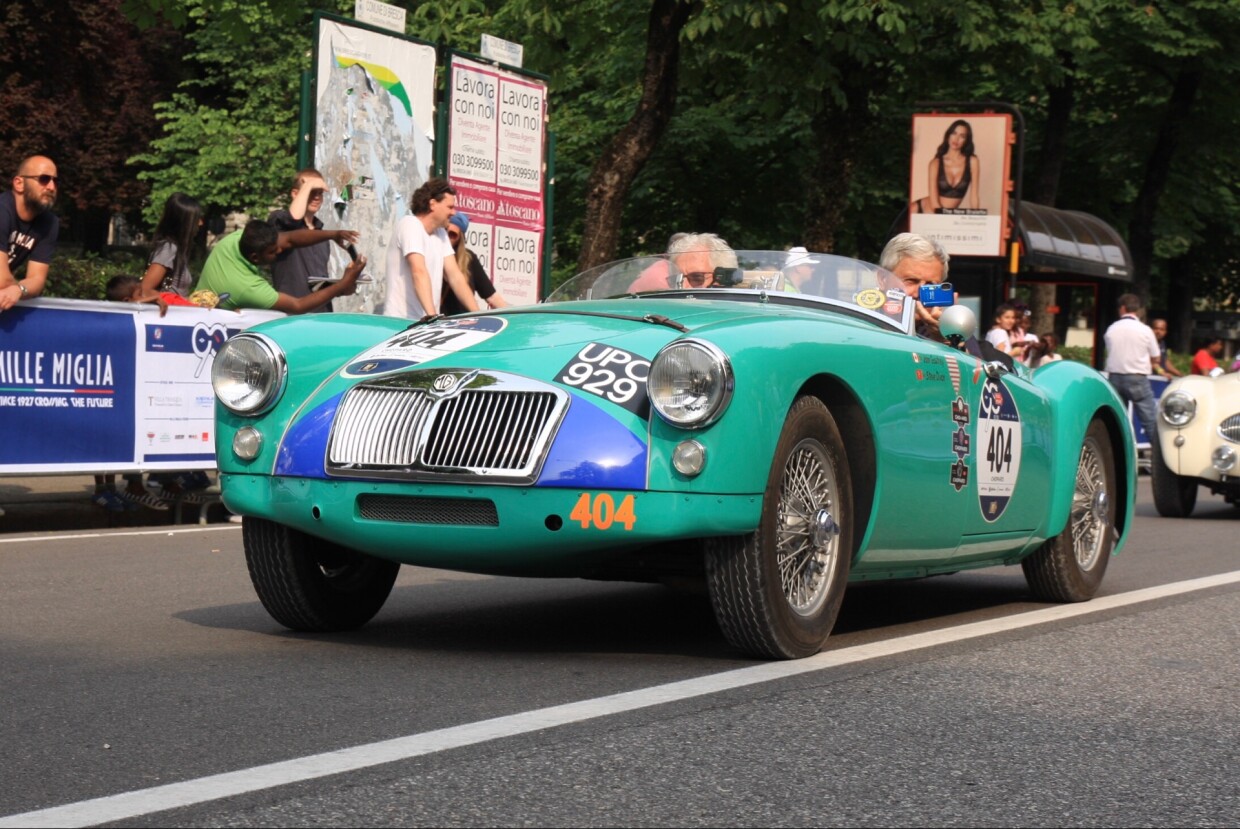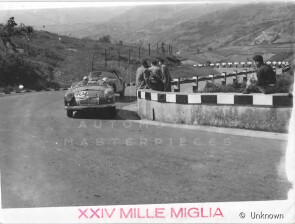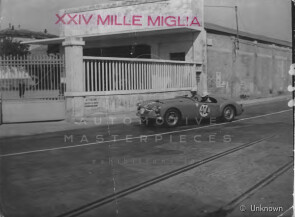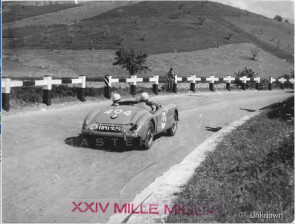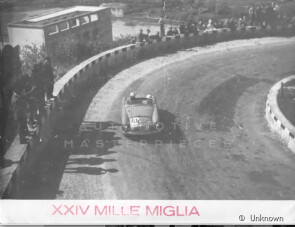
1955 MG MGA
ON/OFF
Why am I an Automotive Masterpiece?
G. Team cars
Fitzwilliams Racing Team (GB)
L. Limited edition cars
no. 6 manufactured. 1 of 6 MG A set up by MG for the 1957 Mille Miglia
The MGA was produced by MG from 1955 to 1962. It replaced the MG TF 1500 Midget and represented a complete styling break from MG's earlier sports cars. Announced on 26 September 1955 the car was officially launched at the Frankfurt Motor Show. A total of 101,081 units were marketed through the end of production in July 1962, the vast majority of which were exported. 5869 cars were sold on the home market, and the MGA was replaced by the MGB. The MGA design dates back to 1951, when MG designer Syd Enever created a streamlined body for George Philips' TD Le Mans car. The new bodywork traded the MG TF's articulated fenders and running board for ponton styling, with a single styled envelope fully enclosing the width and uninterrupted length of a car. The TF featured a high driver seating position. A new chassis was designed with the side members further apart and the floor attached to the bottom rather than the top of the frame sections. A prototype was built and shown to the BMC chairman Leonard Lord. He turned down the idea of producing the new car as he had just signed a deal with Donald Healey to produce Austin-Healey cars two weeks before. Falling sales of the traditional MG models caused a change of heart, and the car, initially to be called the UA-series, was brought back. As it was so different from the older MG models it was called the MGA, the "first of a new line" to quote the contemporary advertising. There was also a new engine available, therefore the car did not have the originally intended XPAG unit but was fitted with the BMC B-series engine allowing a lower bonnet line. The MGA convertible had no exterior door handles, however the coupe had door handles. It was a body-on-frame design and used the straight-4 "B series" engine from the MG Magnette saloon driving the rear wheels through a four-speed gearbox. Suspension was independent with coil springs and wishbones at the front and a rigid axle with semi-elliptic springs at the rear. Steering was by rack and pinion. The car was available with either wire-spoked or steel-disc road wheels. While the make is MG, the model was named MGA by John Thornley in 1954. The first 1500 model: the 1489 cc engine fitted with twin H4 type SU Carburettors produced 68 hp at first, but was soon uprated to 72 hp. Lockheed hydraulic drum brakes were used on all wheels. A coupé version was also produced, bringing the total production of standard MGAs to 58,750. An early open car tested by British magazine The Motor in 1955 had a top speed of 97.8 mph (157.4 km/h) and could accelerate from 0–60 mph (97 km/h) in 16.0 seconds. A fuel consumption of 26.7 miles per imperial gallon (10.6 L/100 km; 22.2 mpg‑US) was recorded. The test car cost £844 including taxes. The Twin-Cam model: a high-performance Twin-Cam model was added for 1958. It used a high-compression (9.9:1 later 8.3:1) DOHC aluminium cylinder head version of the B-Series engine producing 108 hp. Due to detonation problems, a 100 bhp low-compression version was introduced later. Four-wheel disc brakes by Dunlop were fitted, along with Dunlop peg drive knock-off steel wheels similar to wheels used on racing Jaguars, unique to the Twin-Cam and "DeLuxe" MGA 1600 and 1600 MkII roadsters. These wheels and chassis upgrades were used on a small number of the "DeLuxe" models built after Twin-Cam production came to a halt. Aside from the wheels, the only outside identifier was a "Twin-Cam" logo near the vent aside the bonnet. A careful look at the rear wheel vents would also reveal another feature unique to Twin-Cam and DeLuxe: those four-wheel Dunlop disc brakes mentioned above. The temperamental engine was notorious for warranty problems during the course of production, and sales dropped quickly. The engine suffered from detonation and burnt oil. Most of the problems with the Twin-Cam engine were rectified with the low-compression version, but by then the damage had been done. The Twin-Cam was dropped in 1960 after 2,111 (2,210 according to some) had been produced. Production ended in April 1960, but had slowed to a trickle long before. An open car was tested by The Motor magazine in 1958 and was found to have a top speed of 113 mph (182 km/h), acceleration from 0–60 mph (97 km/h) in 9.1 seconds and a fuel consumption of 27.6 miles per imperial gallon (10.2 L/100 km; 23.0 mpg‑US) was recorded. The test car cost £1,283 including taxes of £428. Oddly, an open MGA Twin Cam (index PMO 326), road tested by The Autocar magazine in its 18 July 1958 edition only recorded a 0-60 time of 13.3secs with the standing quarter mile of 18.6secs. The mean maximum speed was 113.5 mph, with a best of 114.0 mph. The 1600 and 1600 De-Luxe model: in May 1959 the standard cars also received an updated engine, now at 1588 cc producing 79.5 hp. At the front disc brakes were fitted, but drums remained in the rear. 31,501 were produced in less than three years. Externally the car is very similar to the 1500 with differences including: amber or white (depending on market) front turn indicators shared with white parking lamps, separate stop/tail and turn lamps in the rear, and 1600 badging on the boot and the cowl. A number of 1600 De Luxe versions were produced with leftover special wheels and four-wheel disc brakes of the departed Twin-Cam, or using complete modified Twin-cam chassis left redundant by the discontinuance of that model. Seventy roadsters and 12 coupés were built. A 1600 open car was tested by The Motor in 1959. It had a top speed of 96.1 mph (154.7 km/h) and could accelerate from 0–60 mph (97 km/h) in 13.3 seconds. A fuel consumption of 29.7 miles per imperial gallon (9.5 L/100 km; 24.7 mpg‑US) was recorded. The test car cost £940 including taxes of £277. The Mark II and Mark II De-Luxe model: the engine size was increased again to 1622 cc by increasing the bore from 75.4 mm to 76.2 mm for the 1961 Mark II MGA. The cylinder head was also revised with larger valves and re-engineered combustion chambers. Horsepower increased to 90 hp. It also had a higher ratio 4:1 rear axle, which made for more relaxed high-speed driving. An inset grille and Morris Mini tail lamps appearing horizontally below the deck lid were the most obvious visual changes. 8,198 Mark II roadsters and 521 coupés were built. Road & Track magazine reviewed the MG A 1600 Mark II in the September 1961 issue and reported an estimated top speed of 105 mph and a 0-60 acceleration of 12.8 seconds. As with the 1600 De Luxe, there were also some Mark II De Luxe versions; 290 roadsters and 23 coupés were produced.
Competition history: the MGA's bodywork was based largely on that of a one-off MG TD specially built by the MG factory at the request of racing privateer George Phillips for the 1951 24 Hours of Le Mans. Later, a new chassis was designed so as to seat the driver lower in the car with even cleaner bodywork resulting in the EX 175 prototype. The later MG prototype EX 182 was very close to the final production MGA and was the car actually raced at Le Mans in 1955. Three MGA prototypes were entered at Le Mans in 1955. Two of the cars finished the race placing 12th and 17th overall, proving the worth of the new car. The third car crashed with serious injuries to the driver, Dick Jacobs. The MGA has been raced extensively in the U.S. since its 1955 introduction and with considerable success. In Sports Car Club of America competition the MGA has won numerous regional and national championships. It has also been a favourite choice of those competing in vintage racing. Kent Prather has been the most successful American MGA driver to date with G Production wins at the SCCA national championships in 1986, 1990, 1995, 2002, 2003, and 2005. Prather and his MGA accomplished this despite the fact that his MGA was often the oldest vehicle competing among several hundred race cars at the SCCA Runoffs. In the United States, the MGA was used in NASCAR from 1960 to 1963 in the Grand National Series, failing to win a single race. After production ended of the MGA, MG (which at that point was the last foreign automaker in NASCAR) decided not to field another entry in the circuit, which resulted in a de facto oligopoly of the NASCAR circuit by Detroit's Big Three. Aside from a brief period in the 1970s when American Motors fielded the AMC Matador in NASCAR competition, not another non-Detroit automaker—let alone a non-American automaker—would enter NASCAR until 2007, when Toyota entered NASCAR competition with the Camry.
The MGA with chassis no. HDE/13/10708 was completed on 5thDecember 1955 with engine 15 GB 655 and supplied new to Richard Fitzwilliam. It was (and is still) painted in Tyrolite Green colour with blue nose: the Fitzwilliam Team colours. The car is usually nicknamed by its UK plate that still bears: UPO 929. Within days of Fitzwilliam receiving the car UPO 929 was back at Abingdon having a number of modifications made, notably the front valance/undertray and close-ratio gearbox. It was then raced extensively at UK National events, including Goodwood and Silverstone, by Fitzwilliam and Robin Carnegie (the Earl of Northesk) with significant MG Works support. Famously, they won the inaugural 3-hour multi-marque Autosport Trophy (on handicap from Ken Rudd in the AC Ace and John Dalton in the Austin Healey 100S) at Oulton Park. Internationally, they completed the Rheims 12 hours albeit eventually on just 3 cylinders. They took it to the Nurburgring 1000km event but were disqualified for receiving assistance on the circuit. An entry to Le Mans 24hrs was accepted but was later aborted at the request of the MG Works, sadly. In 1957, at the heart of the new 4-car Fitzwilliam Racing Team fully supported by the MG Works, UPO 929 was joined by 3 MGA’s loaned by the Works for a season of events comprising national races at the same circuits in UK as in 1956 and the international races at Nurburgring 1000km (again) finishing 41stoverall plus the Mille Miglia finishing 8th in class (Open Sportscars of Limited Price up to 1500cc) and 85thoverall. During 1958, UPO 929 raced some National events before it was retired from racing while Fitzwilliam and Carnegie moved on to the MGA Twin Cam and eventually to Lola cars. The car was acquired in 1959 by Len Hall, a garagiste in Croydon. Hall & the Works initially fitted the HRG-Derrington aluminium crossflow head and the 42DCOE Weber Carburettors. In 1962 the MG Works supplied and fitted a very early development MGB 1800 engine (18S G-U-H 530) to keep the by-now notable MGA racing competitively and continuing their involvement since 1956 in its improvement and development at a time when BMC had forbidden MG to race after 1955. He continued to race the car for many years in National and Club events while still using it as a family driver, resulting in the rear shroud cut-out to accommodate his young son. He passed the car to that son, Jon Hall, who kept it as a running car for events and in England and Europe until he sold it to the present owner late in 2011. So: one-family ownership for 52 years. Just three owners from new if one excludes a very short-term owner in 1959 who bought it from Fitzwilliams and sold it just months later to Hall. During 2013/2014 the car was rebuilt. It still has the unique features acquired in the 1950’s and early 1960’s. The rear-shroud cut-out behind the seats, the engine-bay ventilation (which was used in association with Hall’s temporarily-fitted fibreglass wing shark’s-gill feature fitted in the 1960’s) and the 1956 Works-supplied & fitted front valance/undertray are retained. It has FIVA approval to run if appropriate with its period HRG-Derrington crossflow head with Weber carburettors and with either the original 1500 engine (reputedly prepared by MG for an aborted entry at Le Mans 1956) or the 1962 Works- supplied 1800 3brg MGB engine. After 57 years, in March 2014 it returned to Goodwood for the 72ndMembers Meeting and in May the Mille Miglia re-enactment. In July 2015 it won its class racing on Silverstone’s full circuit at MG Live. It has been back to the Mille Miglia again in 2015, 2016, 2017 & 2018.
